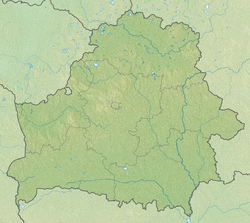Nesvizh Castle
| UNESCO World Heritage Site | |
|---|---|
 View from the lake | |
| Location | Nyasvizh, Minsk Province, Belarus |
| Part of | Architectural, Residential and Cultural Complex of the Radziwill Family at Nesvizh |
| Criteria | Cultural: (ii)(iv)(vi) |
| Reference | 1196 |
| Inscription | 2005 (29th Session) |
| Website | niasvizh.by/en/ |
| Coordinates | 53°13′22″N 26°41′29″E / 53.22278°N 26.69139°E / 53.22278; 26.69139 |
 Location of Nesvizh Castle in Belarus | |
Niasviž Castle or Nesvizh Castle (Belarusian: Нясьвіскі замак, Niasvižski zamak, Polish: zamek w Nieświeżu, Lithuanian: Nesvyžius) is a residential castle of the Radziwiłł family in Niasviž, Belarus. It is 183 metres (600 ft) above sea level.[1]
1919 - 1945 the complex was in Poland and was considered one of the most beautiful castles in the Kresy region.
Contents
1 History
2 Reconstruction
3 Other Radziwiłł castles
4 References
5 External links
History

The Radziwiłł portrait gallery
The estate was owned by the Radziwiłł magnate family from 1533, when it was awarded to Mikołaj Radziwiłł and his brother Jan Radziwiłł after the extinction of the Kiszka family. Since the Radziwiłłs were one of the most important and wealthy clans of the Grand Duchy of Lithuania and the Crown of the Kingdom of Poland, it was there that the Lithuanian Archive was moved in 1551. In 1586 the estate was turned into an ordynacja.
After the Union of Lublin the castle became one of the most important residences in the central part of the Polish–Lithuanian Commonwealth.
In 1582 Mikołaj Krzysztof "Sierotka" Radziwiłł, the Marshal of Lithuania, Voivode of Trakai–Vilnius and castellan of Šiauliai, started the construction of an imposing square three-storey "château". Although the works were based on a pre-existing structure of a medieval castle, the former fortifications were entirely turned into a renaissance-baroque house. Construction was completed by 1604, and they added several galleries half a century later. The château's corners were fortified with four octagonal towers.
In 1706, during the Great Northern War, Charles XII's army sacked the castle and destroyed its fortifications. Several decades later, the Radziwiłłs invited some German and Italian architects to substantially renovate and enlarge the castle. Antoni Zaleski decorated its yellow facades with baroque stucco work. The 16th-century castle gates were also reconstructed, and the two-storey gatehouse tower was crowned with a helm. It was at this time that the three separate buildings surrounding the central courtyard were joined into a single structure.
The most important structure in Nieśwież is the Corpus Christi Church (1587 to 1603), connected with the castle by a dam over a ditch and containing coffins of 72 members of the Radziwiłł family, each interred in a simple coffin made of birch and marked with Trąby coat of arms. Designed by the Italian architect Gian Maria Bernardoni (1541 to 1605), the church is considered the first Jesuit temple patterned after Il Gesù in Rome, the first domed basilica with Baroque facade in the world[citation needed] and the first baroque piece of architecture in Eastern Europe.
Apart from elaborate princely sepulchres, its interior features some late baroque frescoes from 1760s and the Holy Cross altar, executed by Venetian sculptors in 1583.

The main entrance to the princely residence
In 1772, following the third and last partition of Polish–Lithuanian Commonwealth, the castle was seized by Russian forces and the Radziwiłł family was expelled. Soon afterwards the Lithuanian Archive was transferred to Saint Petersburg (where it still remains today), while the majority of works of art gathered in the palace were distributed among various Russian and Polish nobles in support of Catherine the Great. Abandoned both by the original owners and by the Russian army, the palace gradually fell into disrepair. However, it was restored by the Radziwiłłs and between 1881 and 1886 the castle's interiors were renovated by Prince Antoni Radziwiłł and his French wife, Marie de Castellane. They also designed a landscape park in English style. With an area of more than one square kilometre, the park is one of the biggest such facilities in Europe.
After the Polish–Bolshevik War of 1920 the surrounding area and the castle complex became part of the newly established Second Polish Republic.
During the invasion of Poland in 1939, the Radziwiłł family was expelled from the castle by the Red Army. In Soviet times, the castle was used a sanatorium, while the park gradually fell into neglect.

A bird's eye view
In 1994, the castle complex was designated the national historical and cultural reserve. In 2005 the castle complex was listed by UNESCO as a World Heritage Site.[2]
Reconstruction
The ongoing reconstruction has drawn sharp criticism for its "unjustified reconstruction" of several long-demolished structures, notably a bell-tower. In 2002, the upper storey of the residence was destroyed by fire. Six years later, the Belarus edition of the Komsomolskaya Pravda reported that a substantial section of the castle, dating from the 18th century, had been entirely demolished on account of "rotten brick" (see photo).
Other Radziwiłł castles
- Olyka Castle
- Lubcha Castle
- Mir Castle
- Biržai Castle
- Dubingiai Castle
References
^ elevationmap.net
^ "Landmarks, historic and cultural, and natural sites of the Republic of Belarus on the UNESCO World Heritage List". Land of Ancestors. National Statistical Committee of the Republic of Belarus. 2011. Retrieved 12 October 2013..mw-parser-output cite.citation{font-style:inherit}.mw-parser-output .citation q{quotes:"""""""'""'"}.mw-parser-output .citation .cs1-lock-free a{background:url("//upload.wikimedia.org/wikipedia/commons/thumb/6/65/Lock-green.svg/9px-Lock-green.svg.png")no-repeat;background-position:right .1em center}.mw-parser-output .citation .cs1-lock-limited a,.mw-parser-output .citation .cs1-lock-registration a{background:url("//upload.wikimedia.org/wikipedia/commons/thumb/d/d6/Lock-gray-alt-2.svg/9px-Lock-gray-alt-2.svg.png")no-repeat;background-position:right .1em center}.mw-parser-output .citation .cs1-lock-subscription a{background:url("//upload.wikimedia.org/wikipedia/commons/thumb/a/aa/Lock-red-alt-2.svg/9px-Lock-red-alt-2.svg.png")no-repeat;background-position:right .1em center}.mw-parser-output .cs1-subscription,.mw-parser-output .cs1-registration{color:#555}.mw-parser-output .cs1-subscription span,.mw-parser-output .cs1-registration span{border-bottom:1px dotted;cursor:help}.mw-parser-output .cs1-ws-icon a{background:url("//upload.wikimedia.org/wikipedia/commons/thumb/4/4c/Wikisource-logo.svg/12px-Wikisource-logo.svg.png")no-repeat;background-position:right .1em center}.mw-parser-output code.cs1-code{color:inherit;background:inherit;border:inherit;padding:inherit}.mw-parser-output .cs1-hidden-error{display:none;font-size:100%}.mw-parser-output .cs1-visible-error{font-size:100%}.mw-parser-output .cs1-maint{display:none;color:#33aa33;margin-left:0.3em}.mw-parser-output .cs1-subscription,.mw-parser-output .cs1-registration,.mw-parser-output .cs1-format{font-size:95%}.mw-parser-output .cs1-kern-left,.mw-parser-output .cs1-kern-wl-left{padding-left:0.2em}.mw-parser-output .cs1-kern-right,.mw-parser-output .cs1-kern-wl-right{padding-right:0.2em}
External links
| Wikimedia Commons has media related to Niasviž Castle Complex. |
- Official website of the Nesvizh Museums
Nesvizh castle on official website of the Republic of Belarus
Coordinates: 53°13′22.36″N 26°41′30.25″E / 53.2228778°N 26.6917361°E / 53.2228778; 26.6917361